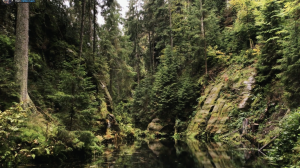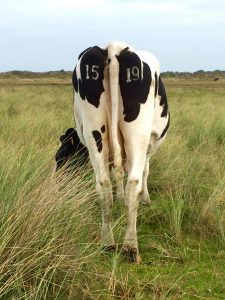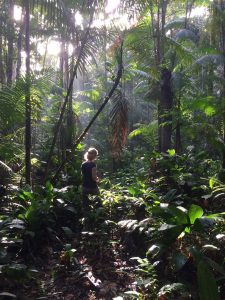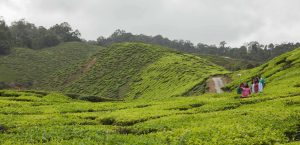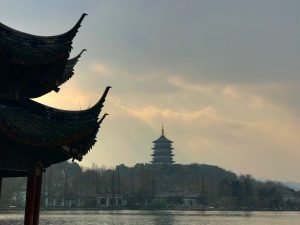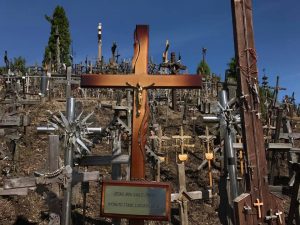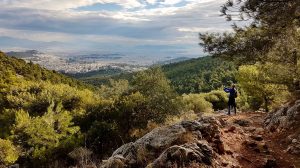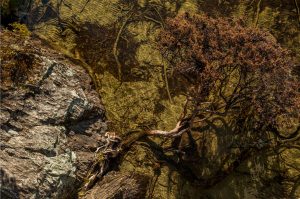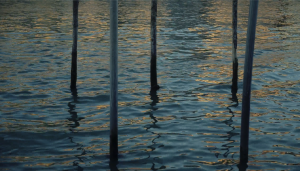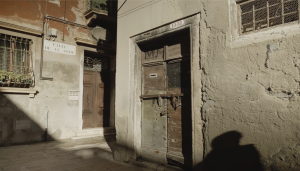We connected with Milton through our mutual friends, Francisco Reiss and Nuno Queirós Pereira, who own the poetry bookshop named Livraria Poetria in Porto, Portugal. Francisco and Milton had worked on a visual poem together named Canção De Uma Sombra (Song Of A Shadow) based on the poem by the famous Portuguese poet Teixeira de Pascoaes.
We immediately fell in love with Milton’s poetry video Song of a Shadow and featured it on TAH and we’ve kept in touch ever since. Milton continues to travel and create breathtaking and heartfelt visual poems and we just can’t get enough of them. So we wanted to know more – who was this mystery man behind the camera?
TravelArtistsHub: What is your artistic focus?
Milton Kam: I am a cinematographer and an essential idea that I strive for in my work is truthfulness. By this I mean to say that I want my images to be a reflection of the truth. This can be my truth, the truth behind a poet’s words, or the truth according to a character in a movie, to give a few examples. Truth can be very interpretive and is perhaps analogous to point of view.

But in my approach to my work, truthfulness comes down to images that make an audience believe the world they are seeing, images that can help them partake in an emotional truth that these images may inhabit.
TAH: How and when did you start creating?
MK: I began to draw since I was able to walk upright, back in Suriname where I was born and raised. I remember when my 2nd-grade teacher summoned my mother to school to tell her that I needed to go to a different school, because I spent the time in class drawing gnomes, airplanes, and horses, instead of learning to write numbers and letters. I thought I had done something wrong until I realized that the teacher was admiring my drawing skills, which were above average.
So, my mother put me in an art program after school hours. It was a traditional art school where drawing, painting, and sculpting were the disciplines being taught. But looking around me at the works of other students, who were usually much older than myself, I felt woefully inadequate. I didn’t feel I had anything profound to say as an aspiring artist, so I didn’t feel like an artist.
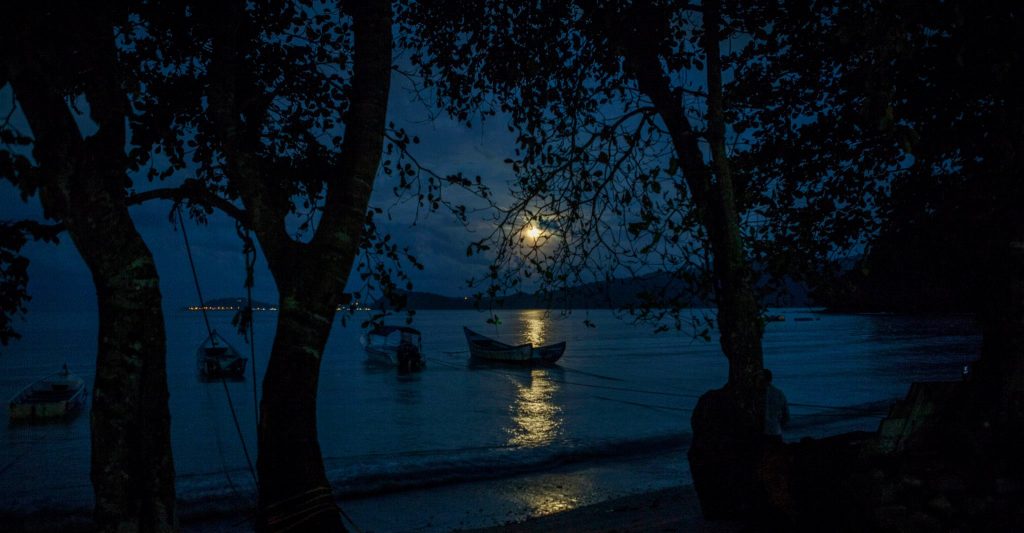
That feeling changed over time as I began to practice my profession when I realized that cinematography can be a way to express oneself, and have the potential to deeply affect how people experience a film.
TAH: Do you travel with or for your art?
MK: It was initially through my work that I began to travel extensively. One of my first overseas assignments was a feature film shot in India, which was followed by a number of other features in the UK. But it is especially my work in documentaries that have shown me how grand and diverse the world is. Today I still travel for work, mainly because I am now based in The Netherlands, and work is often in the US or elsewhere.
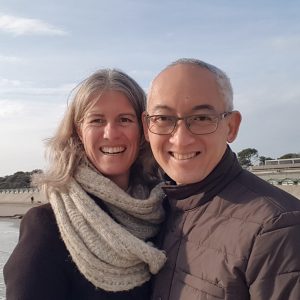
As keen travelers, my wife Heleen and I take to the road as often as we can, traveling on our own whims, or going to various places to do housesits, where we look after other people’s homes and pets.
To keep my skills as a cinematographer alive, while I’m traveling for my own enjoyment and not for work, I began to shoot poetry films based on the works of poets whose city I was visiting.
It began as a mere exercise, but has now grown into a passion project.
TAH: How do you sustain yourself?
MK: I don’t work as regularly as many or most of my peers, but I’m fortunate to be asked to shoot one tv project a year on average, as well as the occasional feature or documentary project. These are enough to sustain me, while also practicing the discipline of frugality, not spending unnecessarily, and avoiding materialistic tendencies. We are able to balance thriftiness with our desire to travel by doing housesits and traveling by train as often as possible.
TAH: Where has your art led you?
MK: The answer to this is perhaps twofold. Work, for which I’m hired, has taken me to several countries in Europe, the Americas, Africa, and Asia. Most memorable for various reasons were India, Rwanda, and Japan. I also have fond memories of working with fantastic crews in New Zealand, Colombia, Spain, and the US of course.
My poetry films, which I’ve been creating for myself, were made in Porto, Athens, Leipzig, Amsterdam, and Venice.
TAH: How has travel influenced your art?
MK: Travel allowed me to experience life beyond my familiar context, which for a long time had been urban and suburban life in New York. When I visited other parts of the world where time and distance are measured differently, where people connect in a deeper way than I was used to, and where peoples’ faces somehow reflected the reality they existed in, I took that experience with me to the narrative films and tv projects I’ve shot.
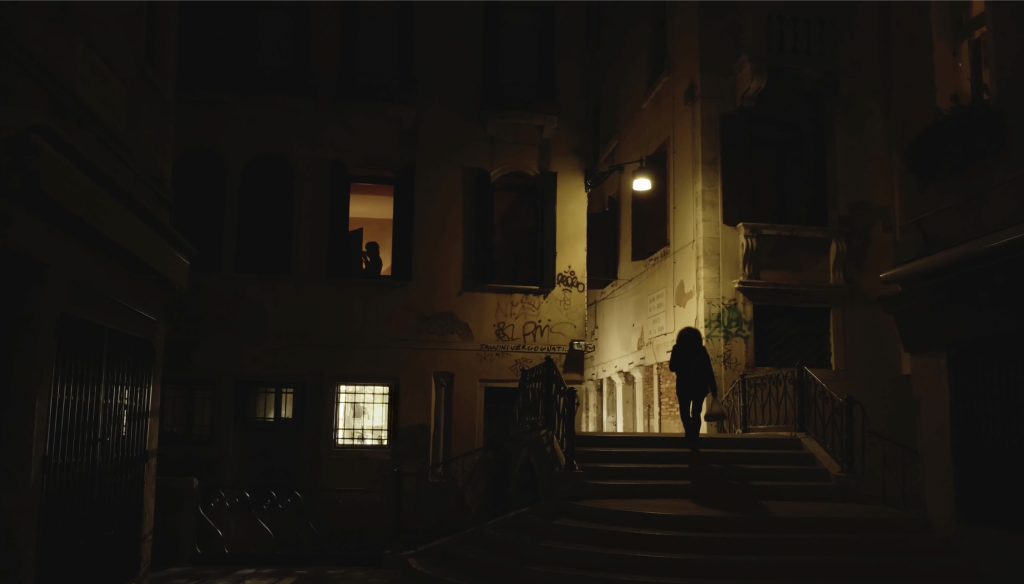
I would try to imbue my images with the feeling and mood I remembered from these experiences, these truths. It isn’t just in the way I light a scene or frame a character or a set that I try to reflect these realities, but also through the kind of input I give to my close collaborators, such as the director or the production designer.
TAH: Have you seen your art influence other art, artists, or cultures?
MK: I’m not sure if my work has influenced anyone, honestly. I do know that in my country of birth, Suriname, people are proud that one of theirs is active in this field internationally. I also like to think that I have a good influence on the people I work with closely. If anything, I hope that my work’s influence on an audience is subconscious and not overt, that it is in the service of a story and its characters, instead of being the center of attention.
TAH: Share your most memorable art travel story.
MK: I think that apart from the traveling I’ve done for my hired work, which has all been really adventurous, my most memorable journey has been photographing the indigenous peoples of my homeland, Suriname.
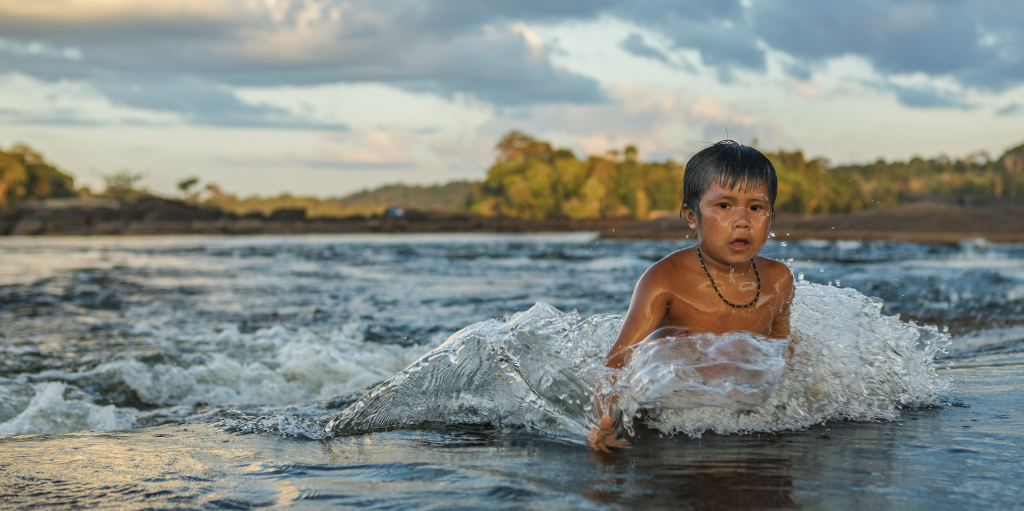
It took a number of years, from 2008 to approximately 2014, to complete the photography for a photo book titled POINTS OF RECOGNITION, which shows how the original inhabitants of the South American continent experience life in modern-day Suriname. From a traditional way of life in the rain forest to urban living in the city.
I was deeply touched to be able to put my art in the service of a people that to this day is affected by the discrimination and disregard that indigenous peoples the world over are subjected to.
I was humbled by these travels, but also made very curious about the wider world.
TAH: How has your art and travel connected you to the wider World?
MK: As a young creative living in New York, I sometimes assumed the falsehood that NY was the center of the world. That pretentiousness died when I met a mother in draught-stricken Kenya who had nothing to feed her children, a man in Kazakhstan who had lost loved ones due to nuclear weapons testing, or child laborers toiling away in a brick factory in Bangladesh.
For each of those people, NYC didn’t matter. Each of these people, and many more, has taught me that beyond the headlines and the news items flashing by on television, there are real people living under challenging circumstances that we’ll never get to meet from our cozy homes. I was humbled by these travels, but also made very curious about the wider world.
TAH: What project are you sharing with the TAH community?
MK: I’m very pleased to share the latest of my five poetry films here. It is titled NELLA MIA CITTÀ (In My City) which was filmed in Venice, Italy, last year. It is based on the poem by the same name, written by the Italian poet Anna Toscano, who lives in Venice.
(Click To View Video Here)
TAH: What inspired you to make this visual poem?
MK: Venice has always fascinated me with its rich history in commerce as well as the arts. I loved Canaletto’s paintings of this unique city and have wanted ever since to see it for myself. Fortunately, an opportunity came to film a documentary there for a couple of days and since then I hoped a project would come my way that would take me there again for a longer period of time.
In the fall of 2020, when Heleen and I discussed where to go for our winter escape, Venice became an enticing option. I wouldn’t have to wait for an assignment. Making a poetry film was the perfect excuse to go and I would be doing it on my own terms, not as an assignment with a schedule and a crew.
TAH: How did you connect with the people and places you visited?
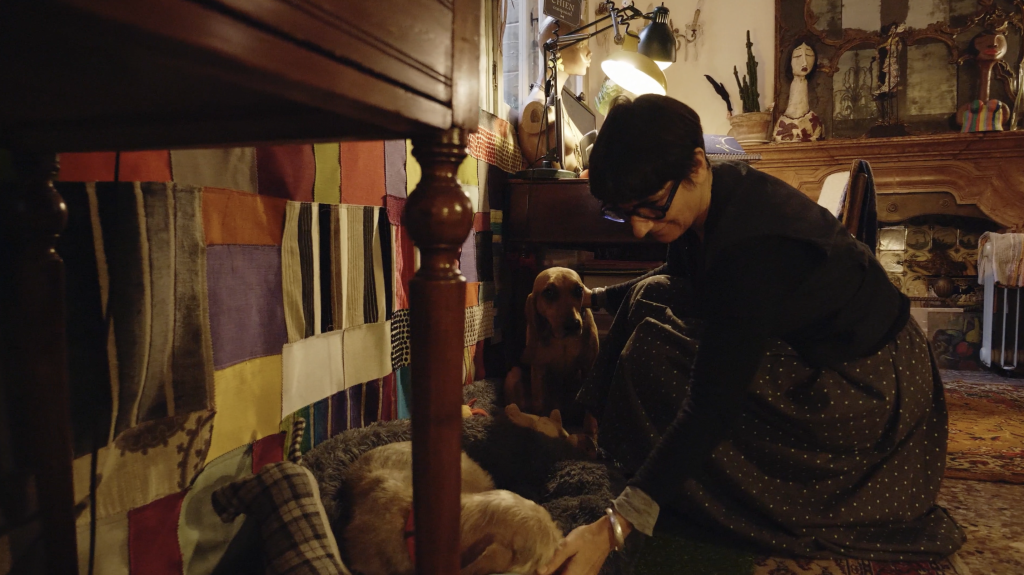
MK: Before arriving in Venice, I began to research local poets online, but couldn’t readily find any poems that felt like a good match with the kind of imagery I was planning to make. At the suggestion of Luisella Romeo, the Venetian tour guide whom I was corresponding with, I made contact with Anna Toscano, whose work I was able to sample online.
She had a style of writing that I felt dug under the surface of her subjects, had an effortless dimensionality, and felt both witty as well as mature.
Anna was happy to participate and sent me a number of her poems. One, in particular, Nella Mia Città, was perfect in every way. The words felt personal, observational, yet lent themselves to the pictorial and contemplative approach I had in mind.
(Poem in the Italian Language)
NELLA MIA CITTÀ
Il futuro non esiste
il futuro non arriva
nella mia città:
per quanto il mio passo sia lungo
per quanto si abbia il favore del vento
il 2 non va a più di 22 km orari.
Come oltrepassare il passato
come non guardarsi indietro
(a questa velocità)
con il collo sempre a tre quarti:
il tempo si ferma a piazzale Roma
così si vive invischiati
nelle storie dei popoli.
Noi si sta, felici,
in uno specchietto retrovisore.
by Anna Toscano
(Poem in the English Language)
IN MY CITY (NELLA MIA CITTÀ)
The future does not exist
the future does not come
in my city:
however long my step is
however much you have the favor of the wind
the number 2 does not go more than 22 km per hour.
How to get beyond the past
how not to look back
(at this speed)
with your neck always at three quarters:
time stops in piazzale Roma
so we live entangled
in the stories of peoples.
We stand, happy,
in a rearview mirror.
by Anna Toscano
Many of the locations I filmed were spotted while strolling through the city with Heleen or by myself. I would mark them on Google Maps in order to come back later with my camera, or during a specific time of day. Often I would come across places which spoke to me on an aesthetic or emotional level.
I would wait for pedestrians or boats to pass through the frame, in order to inject some daily life into the shots.
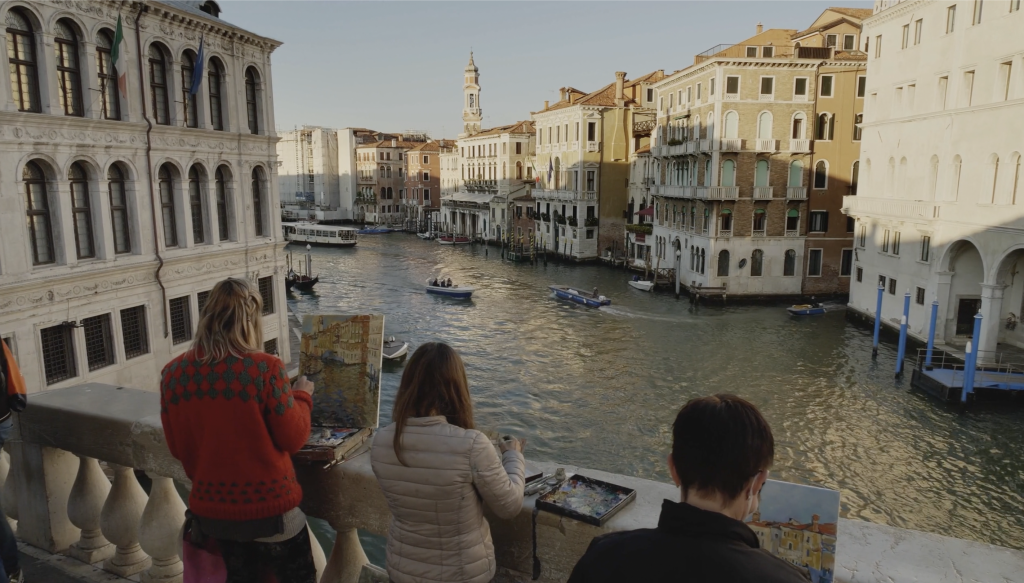
When I found local people performing an activity, which might have been routine to them, but interesting for me to capture, I would either ask them if I may film them in their activity, or I would make an appointment to come back at a later time.
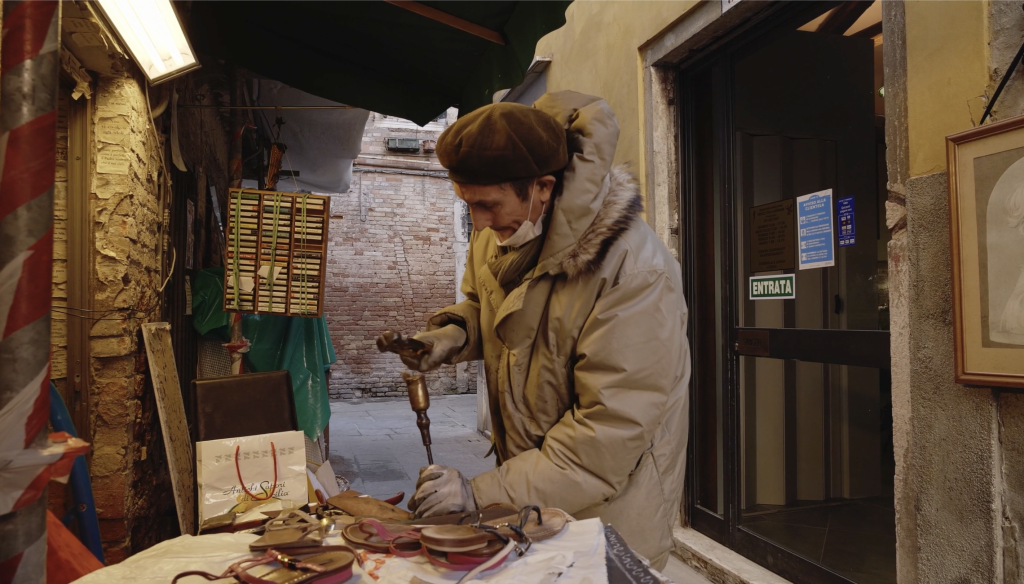
The point to me was to populate my film with everyday humanity. I spotted the woman rowing her boat in an online article and looked her up. While filming her, I met a woman named Jessica Pritchard who in turn introduced me to several people, including the man repairing his boat and the woman hanging her washings on a clothesline.
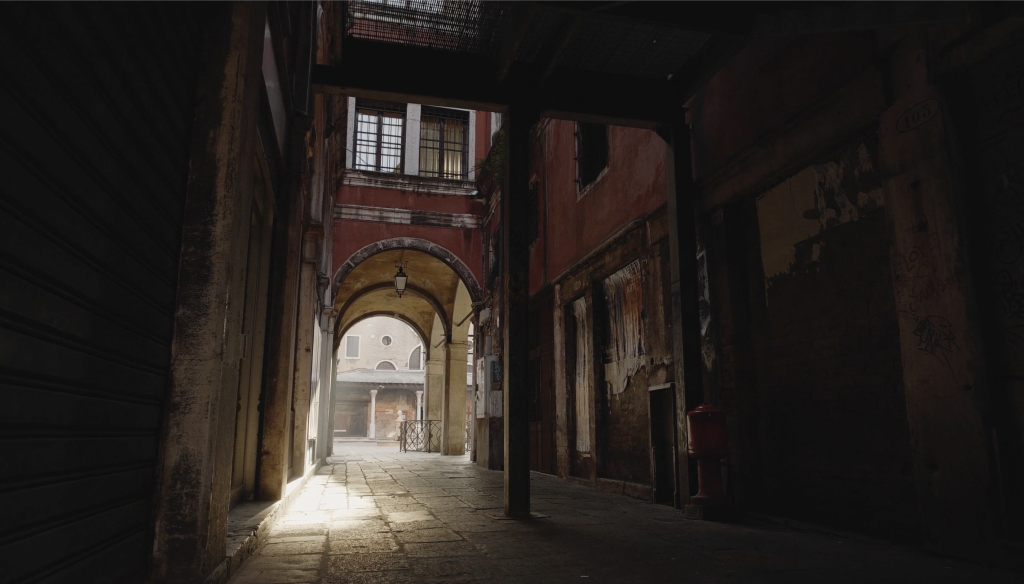
Liesl Odenweller, the soprano who graced the film with her beautiful rendition of Foll’e ‘ben che si crede, one of the most touching melodies I’ve ever heard, was introduced to me by a filmmaker friend. Liesl runs The Venice Music Project which aims to unearth lost or forgotten Baroque music manuscripts and revive them in live or online streaming performances with her ensemble of internationally acclaimed musicians. She recommended Federico Toffano to me, who composed the beautifully haunting cello soundtrack for me.
Finding the places and people who appeared in my film was often a serendipitous process. One chance meeting lead to the next series of great opportunities and getting lost in the labyrinthian city resulted in finding some unique locations. Of course, there were also many false leads that didn’t produce any results!
Can you describe your process in making this film?
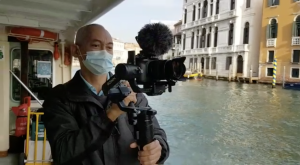
As soon as I arrived in Venice, I set about capturing scenes of everyday life of the city in slow moving shots. I used a small Lumix GH5S camera attached to a stabilizing gimbal, a Ronin SC, which I moved slowly to give the image a dimensionality and a sense of travel. It was a bit like performing tai chi with a camera!
I tried very hard to avoid cliche shots, which wasn’t easy in such a popular place. I preferred not to call too much attention to the craft of filming, eschewing distracting or sensational shots and focusing instead on bringing out the textures and characters of a place.
After I selected Anna Toscano’s poem as the basis for my film, I began to study it for its visual clues. Some lines suggested quite clearly what kind of images they needed, while others were more suggestive of a mood or a tone.
In a document I created on my laptop, which I called a paper edit, I laid out the stanzas of the poem as if they were the score of a piece of music. I would leave blocks of space between the stanzas where there would be images without words. These pauses were an opportunity to present visual themes such as boats or artisans, and to use music.
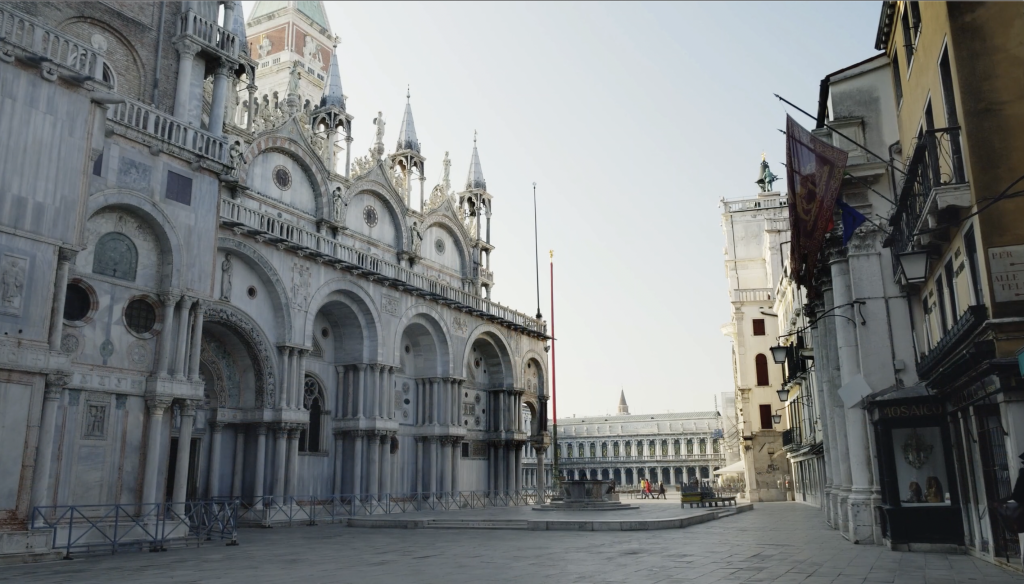
I would then place thumbnail images of clips I had already shot over the words or lines where they seemed to work best as if they were notes placed over the horizontal lines in music notation. This way I could get a sense of the visual rhythm of the film, with the poet’s words providing the context.
Some words or phrases became very important in suggesting what else I needed to shoot, to fill in the blanks. An example is the phrase ‘However much you have the favor of the wind.’ For this line, I filmed Venetian flags and plenty of washings hanging from clotheslines. To me, they were symbolically representative of the wind.
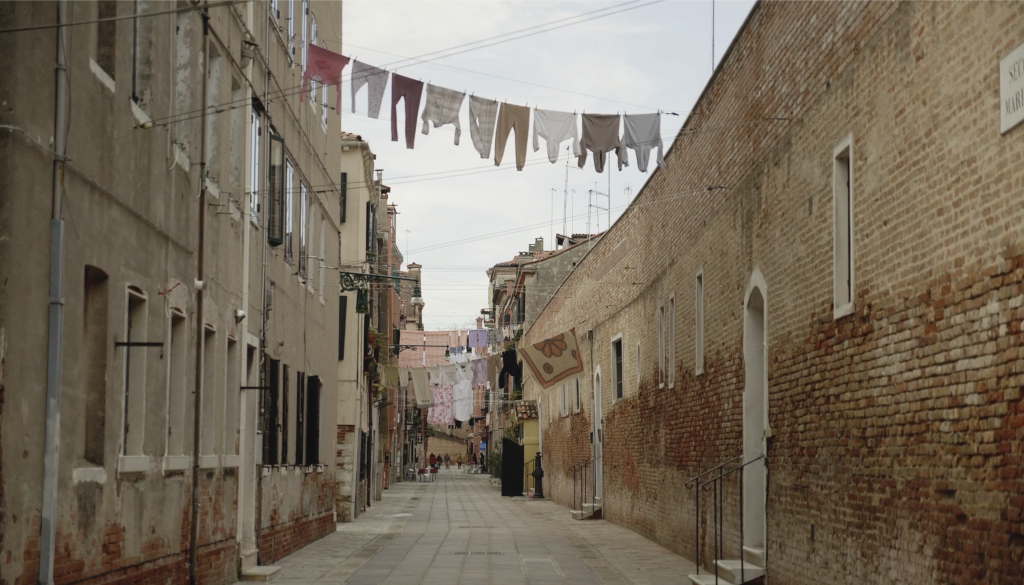
As with my earlier visual poems, I recorded the poet reading her poem. Anna was generous in allowing me to record several variations of her reading, even one version where she would follow each stanza with a whispered repetition. I was actually thinking of asking her to do precisely that repetition in order to increase the duration of the film, which otherwise would have felt a bit short, but then she suggested this idea herself. How lucky I was!
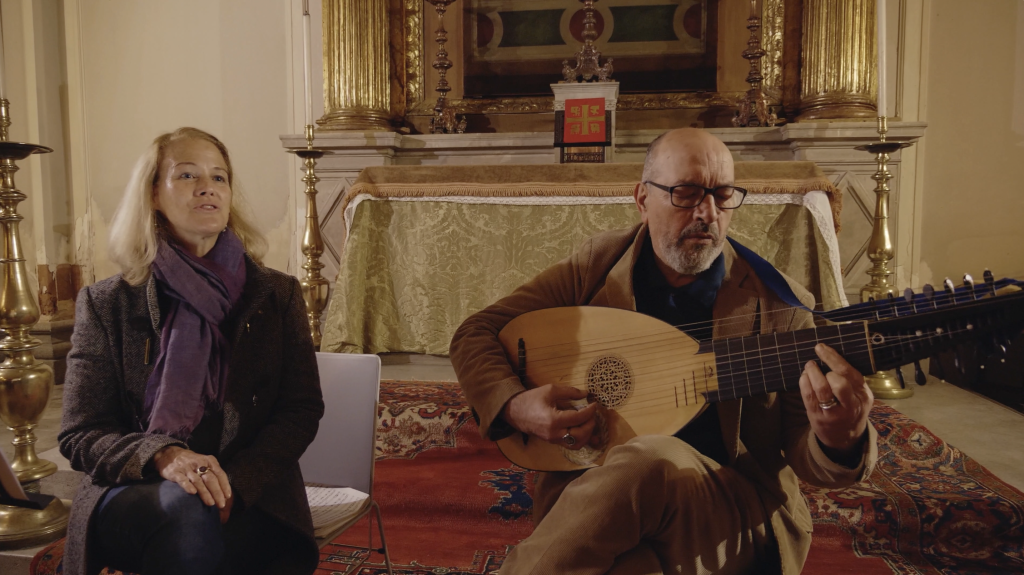
I filmed Liesl Oldenweller while she was rehearsing with members of The Venice Music Project. They were practicing several Baroque-era pieces in preparation for an upcoming live-streaming performance. During the entire session, I wasn’t sure yet which piece of music I was going to use until she sang the beautiful song by Tarquinio Merula, which I used in the film. Again, I felt that serendipity was on my side!
Prior to my recording session with Federico Toffano, I sent him Anna’s poem and spoke with him about what I thought I would need for the musical soundtrack. He prepared a number of cues that were inspired by Bach and other Baroque composers.
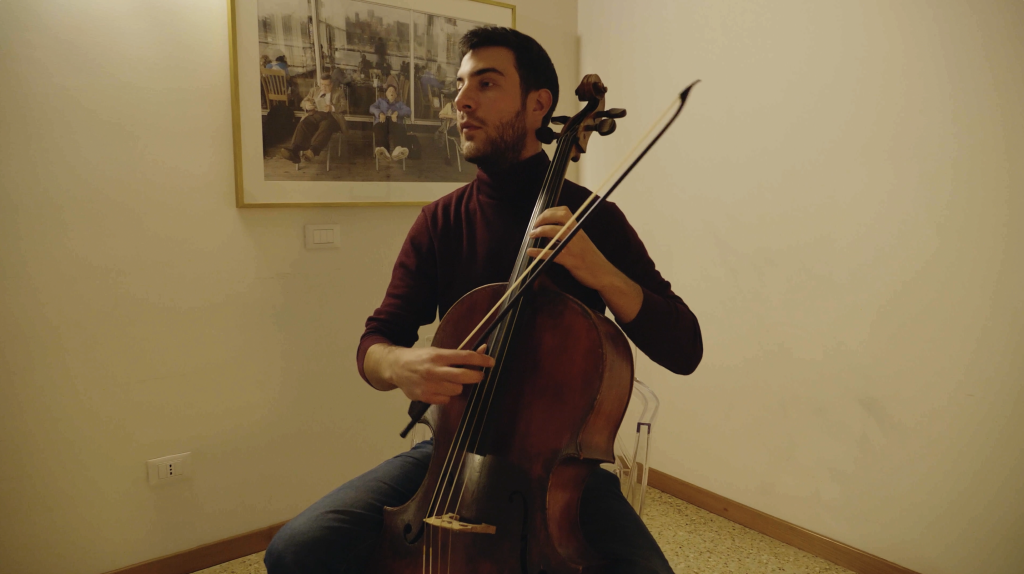
After performing them on his cello for my camera, I did a separate recording session with Frederico just to capture the sound, in which I asked him to riff a little on those cues, extending them, speeding them up or slowing them down, and spontaneously replying with his cello to each stanza of the poem that I would read out loud.
I used these music cues throughout the film where I thought they best worked. These were not only rational, but frequently emotional decisions, as is often the case with my editorial process. It’s usually quite a balancing act that can be filled with uncertainty. I was quite relieved to receive so many positive reactions, especially from Venetians.
TAH: Do you have any future plans?
MK: I’m not really a diligent planner, but rather allow some surprise and serendipity to enter. Of course, I hope to continue making more poetry films. With this in mind, Heleen and I are contemplating spending time in countries like Armenia, Georgia, or Norway, but there are no set plans yet.
We are also working on a project together titled FROM KAMPEN TO MOSCOW, a series on Youtube which began in the Dutch city of Kampen. From there, we travel over ancient trading routes all the way to Moscow. Along the way, we stop in different cities or villages where we look at the historical connections with the present day.
Heleen does the research and presents in front of the camera, while I film her and edit the show. It will take quite a while to reach Moscow, if we ever do! But the journey is the thing.
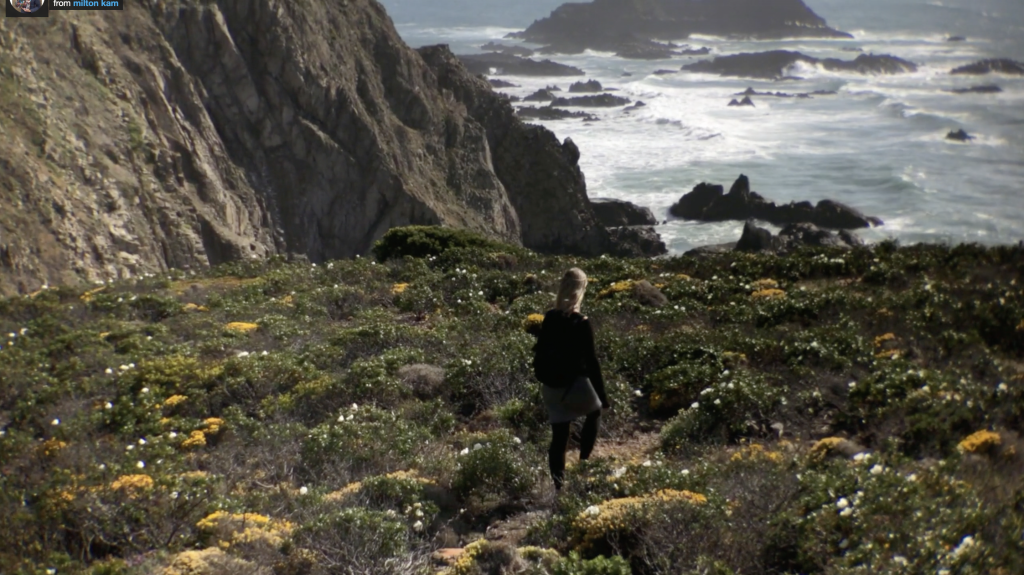
if someone is keen enough to travel and is willing to put time and effort into the necessary research, the world is your oyster
TAH: Do you have any advice for folks interested in following in your traveling footsteps?
MK: There is no doubt to me that doing this together with a partner who is as keen on traveling and discovering as I am, makes it easier and more enjoyable. I also consider myself extremely fortunate to have a profession which offers me the perks of working and creating in interesting places.
Other than having similar circumstances, I would advise anyone looking to do the same to travel to interesting places which are relatively inexpensive, especially during the off-season, when tourism is low. We frequently do house sits, which is a great way to taste local live. We take good care of the pets and homes we sit, so we are often asked to return for subsequent sits.
We also live a frugal lifestyle, traveling by train when possible, taking along only our carry-on as much as possible when having to fly, and by looking for inexpensive deals for housing or groceries. This is how we’ve been doing it, but someone else in different circumstances may have a different approach.
Regardless, if someone is keen enough to travel and is willing to put time and effort into the necessary research, the world is your oyster.
*****
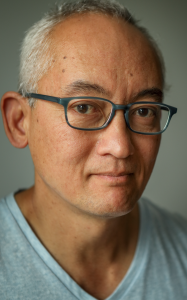
Milton Kam’s work as a cinematographer includes over 20 feature films.
His television credits include assignments such as Amazon Prime’s American Playboy: The Hugh Hefner Story, Netflix’s Roman Empire – Reign Of Blood, NatGeo’s American Genius, The History Channel’s Kingpin, and Sundance TV’s Jonestown: Terror In The Jungle.
One of Milton’s most prolific collaborations is with British director Simon Rumley, with whom he made Red White & Blue, Johnny Frank Garrett’s Last Word, and Fashionista, among others.
Besides various independent films in the US Milton has also regularly shot features in the U.K. One of his favorite shooting experiences is Vanaja, a drama shot in India that won the Silver Bear at the 2007 Berlin Film Festival for director Rajnesh Domalpalli, followed by two nominations for the 2008 Independent Spirit Awards, including one for Best Cinematography and Best Cinematography Award at the Rhode Island International Film Festival.
Milton has also worked extensively in documentaries. Milton’s latest project is the film Before El Finâ, writer/director Nathan Buck’s feature debut shot in Andalusia, Spain.
Feel free to link to Milton’s professional website: www.miltonkam.com
And check out his photobook “Points of Recognition”, about Suriname’s Indigenous Peoples, which he published last year: www.pointsofrecognition.com
Follow Milton and Heleen’s travel journey on Youtube: FROM KAMPEN TO MOSCOW
Check out Milton’s visual poem Song of a Shadow on TAH!
